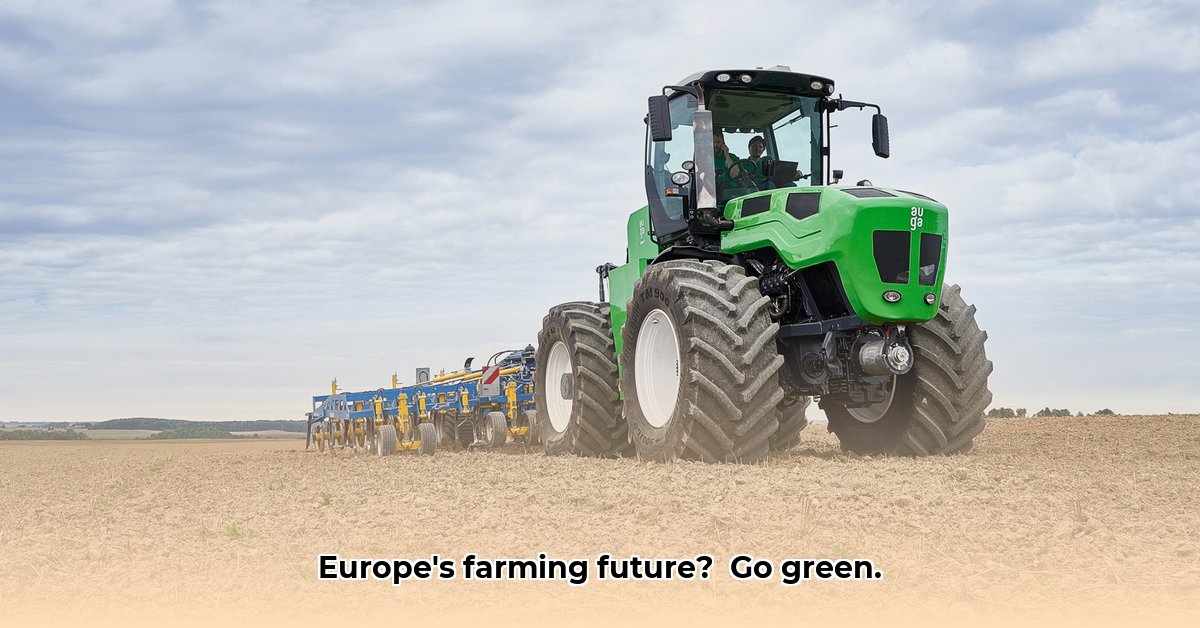
The European farming landscape is undergoing a transformation, driven by escalating costs and a growing urgency to adopt sustainable practices. A key element of this shift is the increasing popularity of pre-owned tractors. This informational guide explores the benefits and challenges of navigating the European pre-owned tractor market, offering actionable steps for farmers, dealers, governments, and NGOs to foster a more sustainable and economically viable agricultural sector. Buying a used tractor can save farmers thousands, making environmentally sound practices financially accessible. For more in-depth guidance, check out this helpful guide.
Understanding the European Used Tractor Market: A Diverse Landscape
The European pre-owned tractor market is a diverse ecosystem encompassing a wide range of brands, models, and ages. From well-established, robust older models to more recent releases, the variety is considerable. While precise sales data is scarce, anecdotal evidence suggests a significant increase in demand, driven by the growing need for cost-effective solutions and sustainable farming practices. The geographical distribution of farms and tractors across Europe adds complexity, particularly concerning logistics and transport costs. This diversity presents both opportunities and challenges; a thorough understanding of the market is essential.
The Allure of Pre-Owned Tractors: More Than Just Savings
The advantages of purchasing a pre-owned tractor are multifaceted. The most immediate benefit is the substantial cost savings compared to new models. This allows farmers to reinvest savings into other crucial aspects of their operations, such as upgrading technology or expanding their land holdings. Furthermore, many older tractor models boast remarkable durability and reliability, often proving well-suited to specific tasks or terrains. But beyond the financial benefits lies a significant environmental advantage: extending the lifespan of existing machinery reduces the demand for new production, thereby minimizing the environmental impact associated with manufacturing new tractors and decreasing the carbon footprint. This represents a considerable step towards more sustainable agriculture.
Navigating the Challenges: Potential Pitfalls and How to Avoid Them
While purchasing a used tractor presents considerable advantages, it's crucial to acknowledge potential risks. Mechanical issues remain a possibility, underscoring the necessity of thorough pre-purchase inspections by a qualified mechanic. Financing a used tractor can also prove more challenging than securing a loan for a new machine; careful financial planning, including exploring various financial institutions and options like leasing, is vital. Finally, responsible end-of-life management, including environmentally sound disposal or recycling, is a crucial consideration to minimize environmental impact.
Actionable Steps: Your Guide to Navigating the Pre-Owned Tractor Market
This section provides practical steps for various stakeholders to optimize the pre-owned tractor market’s benefits and reduce its inherent risks.
For Farmers:
- Thorough Pre-Purchase Inspection: Always engage a qualified mechanic for a comprehensive inspection before committing to a purchase. This single step can prevent considerable future expenses.
- Strategic Financial Planning: Explore multiple financing options, including bank loans, agricultural credit unions, and private financing, comparing interest rates and terms meticulously.
- Warranty Negotiation: Seek a warranty—negotiate carefully to protect against unforeseen repairs.
- Preventative Maintenance Program: Establish a preventative maintenance schedule to maximize the tractor’s lifespan and performance and minimize downtime.
- Responsible End-of-Life Planning: Research environmentally friendly disposal methods for your tractor at the end of its working life.
For Dealers and Online Platforms:
- Enhanced Online Presence: Invest in a user-friendly website with high-quality images and detailed descriptions of tractors, facilitating informed decision-making by buyers.
- Streamlined Service Delivery: Provide efficient inspection services, transparent pricing, and reliable delivery options to enhance the buyer experience.
- Financial Partnerships: Collaborate with financial institutions to offer diverse financing options to a wider range of buyers.
- Comprehensive Warranty Programs: Offer comprehensive warranty packages that provide buyers with peace of mind and reduce purchasing hesitation.
For Governments and NGOs:
- Financial Incentives for Sustainable Practices: Implement financial incentives, such as subsidies or tax breaks, to encourage farmers to adopt pre-owned tractors.
- Skills Development Programs: Invest in training programs focused on the maintenance and repair of older tractor models, fostering a skilled workforce capable of ensuring long-term operational efficiency.
- Harmonized End-of-Life Regulations: Develop clear and harmonized regulations for responsible disposal of end-of-life agricultural equipment across Europe.
- Research and Data Collection: Fund research to analyze the environmental impact of pre-owned versus new tractors, informing policy decisions based on credible data.
Mitigating Risks: Proactive Strategies for a Smooth Transaction
The following table outlines potential risks and offers mitigation strategies:
| Risk Category | Risk | Mitigation Strategy |
|---|---|---|
| Mechanical Problems | Unexpected breakdowns | Comprehensive pre-purchase inspection; extended warranty; preventative maintenance |
| Financing Difficulties | Difficulty securing financing | Explore multiple financing options; prepare a strong loan application; consider leasing |
| Transportation Challenges | High transport costs and delays | Plan transport logistics carefully; compare quotes from multiple transporters; factor transport costs into your budget |
| Environmental Concerns (Disposal) | Improper disposal of the old tractor | Research and choose certified recycling or responsible disposal facilities; comply with local regulations |
Shaping the Future: The European Regulatory Landscape
Harmonization of regulations across Europe is essential to unlocking the full potential of the pre-owned tractor market. Standardized safety and environmental guidelines will enhance buyer confidence and protect the environment. Progress towards a unified regulatory framework is crucial to fostering cross-border trade and maximizing the economic and environmental benefits of a robust pre-owned tractor market.
Conclusion: Embracing Sustainability Through Smart Choices
The pre-owned tractor market offers a compelling opportunity to build a more sustainable and economically resilient European agricultural sector. By understanding the benefits, acknowledging the challenges, and implementing the suggested strategies, farmers, dealers, governments, and NGOs can collectively contribute to a smoother, more sustainable and cost-effective farming future. The choice to embrace pre-owned tractors is a significant step towards a circular economy in agriculture.